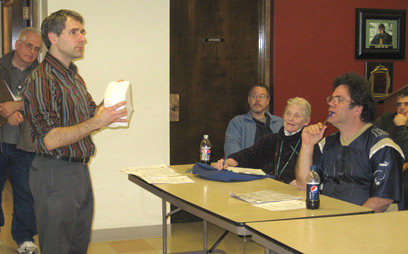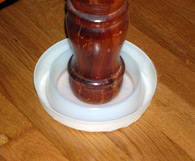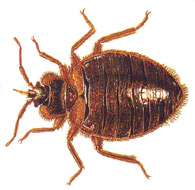

 SEATTLE — December 31, 2009 — Many people think of bedbugs only as the stuff of grandma’s bedtime quips. Unfortunately, these pests are rearing their ugly little heads again around the country, including here in Seattle.
SEATTLE — December 31, 2009 — Many people think of bedbugs only as the stuff of grandma’s bedtime quips. Unfortunately, these pests are rearing their ugly little heads again around the country, including here in Seattle.
The population of bedbugs has increased dramatically in the past three years, and the Seattle Housing Authority has found itself on the forefront of the fight to get them out of people’s beds and put them back into folklore. To this end, the Housing Authority recently outlined an increased effort to stem the spread of the pests in its housing units.
There are three major initiatives to Seattle Housing Authority’s campaign. First, there has been an increase in pest control resources. "We have reinforced our efforts by committing several hundred thousand additional dollars to new pest control staff to handle the uptick in treatment requests and other measures," said Bill Petersen, Pest Control Supervisor.
This commitment also includes tools such as heat treatment equipment and continued use of the Housing Authority’s recently-acquired trained detection dog. Residents are being asked to refrain from using over-the-counter remedies, which are not generally effective and can often just scatter the pests instead of eliminating them.
Second, residents are being supplied with tools to deal with bedbug problems in their homes and to prevent problems from happening in the first place. These tools include things that can make life easier if bedbugs appear, such as bite-proof mattress covers, new bed frames and traps. The idea is make sure the place where people sleep is a "safe haven" to keep the bugs at bay.
Finally, the Housing Authority is expanding educational resources and other assistance to residents to help prevent and deal with bedbugs in the long term.
A common way bedbugs spread is by hiding on used mattresses or other furniture, so residents need to learn to evaluate what they allow into their homes. Also, while clean housekeeping alone cannot protect against bedbugs, it is important to reduce the number of places bugs can hide. Avoiding cramped conditions due to attempting to store too much stuff in a small apartment is important. Clearing out excessive possessions or clutter reduces bedbug hiding places and makes treatments more effective. Prompt reporting is also critical so that pest control can be most effective. "We understand that successfully controlling bedbugs requires a long-term commitment on the part of both the landlord and the resident," said Petersen.
Meetings and inspections, plus bedbug control policy in leases
Highlighting the commitment required to address bedbugs, the Seattle Housing Authority included an addendum dealing with pest control into its standard lease with residents in November 2009. The addendum has been posted in all properties, and is included with each lease renewal.
This policy outlines steps residents must take to make controlling pests possible in their apartments, such as ensuring there is good enough access to all areas of the unit for pest control staff to do their work. Also, the policy emphasizes the fact that bedbugs are more easily spread when they hitch a ride on items like discarded furniture or infested personal possessions, so preventative measures like using plastic bags are necessary.
Residents of Denny Terrace apartments learned more about the pest control policy at a meeting on November 30 as part of a presentation about the stepped-up bedbug control measures. While ongoing bedbug treatments are occurring at properties throughout the Housing Authority, Denny Terrace has been the focus of recent efforts. This is one of the largest apartment buildings, with 220 units, and was the site of the earliest known appearances of bedbugs. The control methods used at Denny Terrace will be refined and rolled out across the agency.
Bedbugs threatened to get the upper hand at Denny Terrace last year, when inspections by the specially trained detection dog revealed their presence in up to 50 units at one time. After over 100 pest control treatments, including follow-ups, the problem has been reduced. A re-inspection of every unit at Denny Terrace in late November as a part of the enhanced bedbug control measures turned up 10 units with bedbugs, so treatments will continue, including in the common areas of the building. There is a team of pest control technicians on duty every day at Denny Terrace, and another sweep by the detection dog is also planned for early 2010.
To someone who has been bitten by bedbugs in their home, even one is too many. But even with an aggressive treatment program, it is impossible to eliminate every bedbug right away. The Housing Authority is taking several measures to help stop bedbugs from reaching people while they sleep, even if bedbugs are present. The idea is to make sure the bed becomes a safe haven from these pests, instead of a nesting place for bedbugs.
First, special covers can be installed over mattresses to trap any bedbugs that are living inside and prevent them from biting. The covers will not only kill those already present, but they are also designed to eliminate seams and crevices where bedbugs commonly nest. The Housing Authority is buying thousands of these high-quality covers and distributing them to residents free of charge. During the recent inspections at Denny Terrace, mattresses were measured to provide the right size for every resident’s bed.
Another key is to make sure beds are raised off the ground, on a bed frame, for example. Then, a special trap can be installed under each bed frame leg to stop bedbugs from crawling up to feed and then back down to hide elsewhere in the apartment. The traps were installed on every bed possible at Denny Terrace, and free bed frames were made available to those without one. Abdirahman Guleed was one of the first residents at Denny Terrace to install a new bed frame and dispose of his old infested mattress in December. He reported that it has made a big difference already. "I haven’t noticed any new bites, and will be checking the traps to report if any bedbugs get in there. This has been a big help so far!"
Guleed’s comments highlight other key elements in bed bug control: reporting bed bug activity and cooperating with Pest Control treatments. Learning how to recognize bedbug activity and promptly calling for treatment is important for residents so that small numbers of bedbugs don’t expand into a bigger problem that is much harder to treat and can affect neighbors and the rest of the building. "Do it yourself" products or remedies are no replacement for the methods used by professional pest controllers, and can just make matters worse by scattering rather than eliminating bedbugs.
Preventing bedbugs from biting is one thing, but perhaps one of the most difficult aspects of bedbug control is eliminating their hiding places. Their favorite hiding and breeding places are in beds, but they also hide in many other tight, dark places – behind furniture, between couch cushions, under piles of clothing or even in the spaces between the corrugations of cardboard boxes.
The ways some people store their possessions and arrange their apartments can provide places for bedbugs to hide, especially in the compact spaces offered in most Housing Authority apartments. If items are piled high or there are areas that remain undisturbed for a long time, bedbugs can find the places they need to multiply, out of reach of pest control treatments.
To help residents organize, rearrange or dispose of excess items, as well as install bed frames and mattress covers, the Seattle Housing Authority is working to provide helpers and other assistance to residents who need it.
Reducing the places where bedbugs can hide is perhaps the trickiest step, and the one that will require the most long term commitment from residents and Housing Authority staff. However, without it, even the most aggressive treatment plans can’t be effective, explains Bill Peterson, head of Pest Control at Seattle Housing Authority.
Background
The Seattle Housing Authority is responding to increased reports of bedbugs in some of the 4,500 rental units it manages and rents to low income residents in Seattle. Over the past year alone, there have been over 200 reports of bedbugs, whereas there were none as recently as early 2007. While not all of those reports turn up bedbugs, the housing authority recognizes that this is a serious issue that affects the lives of its tenants in considerable ways.
While New York City has been dealing with the pests for a number of years, the upsurge in bedbugs is relatively new to Seattle. "When we got our first report about 2 ½ years ago, I had not seen a report of bedbugs since I treated an insurance office in Bellevue over 15 years ago," recounted SHA Pest Control Technician Glenn Lindenmuth, who has about 30 years experience in the field and over a decade at the Housing Authority. Now, the Housing Authority schedules a treatment in its housing stock just about every day.
How bedbugs behave
Bedbugs are tiny insects that puncture human skin to feed on blood, not unlike mosquitos. The adults measure about 3/16 inch in diameter, and look in size and color like a small apple seed with legs. But unlike buzzing insects or fleas (which are sometimes confused with bedbugs), they don’t pounce on people who are actively moving around. They retreat to hiding places during the day, and only come out to feed late at night when people are asleep. They seem to be attracted to the rhythmic breathing of sleeping hosts, according to Peterson. "Some of the most elaborate bedbug traps use carbon dioxide pumps and pheremones to mimic a sleeping human."
Some favorite hiding and breeding places of bedbugs are the folds and crevices of mattresses and box springs, hence the name "bedbugs." However, they hide in many other tight, dark places, like baseboards, between couch cushions, under piles of clothing or even in the spaces between the corrugations of cardboard boxes. They are also fairly hardy—living for many months without a meal—and reproduce quickly. A single female can lay 5-7 eggs after each feeding.
While Public Health officials believe that bedbugs pose no threat of carrying disease, their bites often lead to itchy welts that can lead to skin infections when scratched. Perhaps just as bothersome as the actual bite is the psychological factor that they come out at night and crawl on people who are fast asleep and thus at their most vulnerable. "Anyone who has been bitten is creeped out by just the thought of them." explained one resident who wished to remain anonymous.
There is a stigma attached to having bedbugs that makes people reluctant to admit they have them. There is a false belief that bedbugs are a sign of uncleanliness. However, while keeping up with mopping or vacuuming and washing dishes can help keep pests like cockroaches at bay, just cleaning up after oneself does not guarantee freedom from bedbugs. Hotels, even expensive ones that do excellent housekeeping, can harbor bedbugs more often than travelers might want to face. Bedbugs just need access to a sleeping human and a place to hide. Unfortunately, they can hide just about anywhere. This makes them a very stubborn foe.
